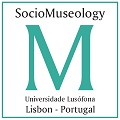O uso do co-design em projetos de acessibilidade em museus para pessoas com deficiência visual
Resumo
O presente artigo tem como objetivo fazer uma análise do uso do co-design em projetos de acessibilidade para pessoas com deficiência visual em museus. Procurou-se discutir o estado da arte de práticas de participação em projetos museais, em específico as metodologias de co-design. Em seguida é feito um estudo de caso comparativo em que foram analisados artigos que descrevem a implementação de projetos de co-design em contexto museal e educativo. O objetivo da comparação foi demonstrar as diferentes metodologias de co-design, quais objetivos podem ser alcançados por essas metodologias e analisar e comparar os resultados e desafios encontrados. Dentre os projetos encontrados foram selecionadas quatro pesquisas para o estudo comparativo analisando suas diferenças e semelhanças. Conclui-se que as práticas participativas trazem como benefício não somente a fidelização e formação de novos públicos, mas o enriquecimento do próprio objeto museal, promovendo novas formas de fruição e aquisição de conhecimento. Pretende-se com este artigo contribuir para o desenvolvimento de futuros estudos e projetos de acessibilidade que ofereçam melhores condições de inclusão social e de democratização do espaço expositivo.
Palavras-chave: co-design; acessibilidade; deficiência visual; museu
Downloads
Política para Periódicos de Acesso Livre
Autores conservam os direitos de autor e concedem à revista o direito de primeira publicação, com o trabalho simultaneamente licenciado sob a Licença Creative Commons Attribution que permite a partilha do trabalho com reconhecimento da autoria e publicação inicial nesta revista.













